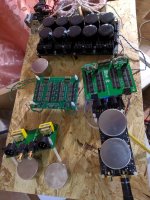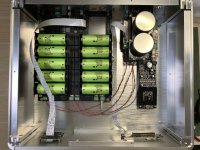I have builded PC for Roon already:
Core i3 9100F (9700K 5 time more expensive than 9100F, so want to strat from this at first)
Gigabyte H370M D3H GSM-CF
8Gb DDR4
SSD M.2 PCIe Plextor, 128GB (PX-128M8SeGN)
Corsair TX650W
CUDA Quadro 600 (This card was purchased many time ago for CAD progrmas but... I saw some "magic" words about CUDA offload for HQP and installed it into chasisBut still do not know will it bring any sense in efficiency or not?
So, I hope it can allow me to start the show with HQP within few days...
Since you can download the trial program, no harm in trying your PC.
Cuda can offload some tasks, but not the EC modulators. So Cuda won't help you to get to higher rate EC, but it can help with some other processing. Since I have an I7 I'm not using Cuda at all.
I think I've seen guys say they get 256EC with an I5 (surprising to me), but I don't think I've seen anyone do it with an I3. But you can try lower rates and see how it goes. I've not tried it, but people say lower rate EC sounds better then high rate non ec mods.
Worst case is you can't do EC, but you would be able to use the HQP3 version modulators instead.
Other thing is I dedicated my PC to HQP. There is nothing else loaded on it, it's only purpose is HQP. Running roon or other stuff will be at the expense of HQP.
I have builded PC for Roon already:
Core i3 9100F (9700K 5 time more expensive than 9100F, so want to strat from this at first)
Gigabyte H370M D3H GSM-CF
8Gb DDR4
SSD M.2 PCIe Plextor, 128GB (PX-128M8SeGN)
Corsair TX650W
CUDA Quadro 600 (This card was purchased many time ago for CAD progrmas but... I saw some "magic" words about CUDA offload for HQP and installed it into chasisBut still do not know will it bring any sense in efficiency or not?
So, I hope it can allow me to start the show with HQP within few days...
The Signalyst website specifies that to use CUDA with HQP you need a graphics card with a compute capability of 3 or more; your Quadro 600 has a capability of 2.1.
D
Deleted member 537459
Thank you, guys! Really helpfull info. Is there some formula that can explain the relation between filters and CPU capability needed? Flops/freqs/speed/etc...
I know of no magic formula but there's information around here and on other forums. Here's a link to my own recent experience;
https://www.diyaudio.com/forums/digital-line-level/254935-signalyst-dsc1-161.html#post5951498
I've yet to run HQP4 on my dedicated music workstation but hopeful it will be a step up.
BTW, have you picked up on the use of transformers on the outputs of DSD decoder projects like the Signalyst DSC2 - maybe something you will consider addressing?
I could be wrong, but have a feeling that modern computing power and mathematical HQP algorithms for DSD-processing - (to put it mildly), do not correlate with each other... Anyway, thanks for inputs!
Still have no more that I have said day ago:
#253
BTW, have you picked up on the use of transformers on the outputs of DSD decoder projects like the Signalyst DSC2 - maybe something you will consider addressing?
Still have no more that I have said day ago:
#253
Still have no more that I have said day ago:
#253
I missed that. Interesting!
So, here the very first results of HQP4 trying.
I don't know why, but I did not worked out to install HQP4 on Ubuntu 19.04 - simply do not wants to installing, without any errors. Have reinstalled OS to 18.04 and HQP4 Desktop installed without problem.
1. ASDM7EC -> 44.1x512 - no chances at all at any filters - all the CPUs are overloaded.
2. ASDM7EC -> 44.1x256 - playback is flawless if there are 85-100% of usage for 1-st and 3rd CPUs and under 80% for 2nd and 4th CPUs within all filters except of following:
poly-sinc-xtr-lp/mp (is OK under 44.1x128)
closed-form (is OK under 44.1x128)
closed-form-16M (drops even at 44.1x128!)
sinc-m (is OK under 44.1x128)
I don't know why, but I did not worked out to install HQP4 on Ubuntu 19.04 - simply do not wants to installing, without any errors. Have reinstalled OS to 18.04 and HQP4 Desktop installed without problem.
1. ASDM7EC -> 44.1x512 - no chances at all at any filters - all the CPUs are overloaded.
2. ASDM7EC -> 44.1x256 - playback is flawless if there are 85-100% of usage for 1-st and 3rd CPUs and under 80% for 2nd and 4th CPUs within all filters except of following:
poly-sinc-xtr-lp/mp (is OK under 44.1x128)
closed-form (is OK under 44.1x128)
closed-form-16M (drops even at 44.1x128!)
sinc-m (is OK under 44.1x128)
So, here the very first results of HQP4 trying.
I don't know why, but I did not worked out to install HQP4 on Ubuntu 19.04 - simply do not wants to installing, without any errors. Have reinstalled OS to 18.04 and HQP4 Desktop installed without problem.
1. ASDM7EC -> 44.1x512 - no chances at all at any filters - all the CPUs are overloaded.
2. ASDM7EC -> 44.1x256 - playback is flawless if there are 85-100% of usage for 1-st and 3rd CPUs and under 80% for 2nd and 4th CPUs within all filters except of following:
poly-sinc-xtr-lp/mp (is OK under 44.1x128)
closed-form (is OK under 44.1x128)
closed-form-16M (drops even at 44.1x128!)
sinc-m (is OK under 44.1x128)
Ivan, it come at no surprise your results. I run the EC modulators @512 with an I9-9900K processor from intel and the help of CUDA. I don´t think you will be able to use any less powerful machine for that job judging the by load on my machine. HQP4 is more efficient in terms of CPU that the previous version as well. Just my two cents
Let me check and I will be back with that info. Since I am also filtering 6 channels with HQPlayer for crossover purposes, my machine had to be powerful enough to do all that work.
Regarding Jussi, there are several threads in Where HiFi and High Tech Converge with respects to hqplayer. Particularly, the following thread: HQPlayer4 EC modulator tips and techniques - Software - Audiophile Style
He posts by the nick of Miska. Try searching also in that forum, there are other threads talking about many aspects of HQPlayer. Hope you find that useful
cheers
Pepe
Regarding Jussi, there are several threads in Where HiFi and High Tech Converge with respects to hqplayer. Particularly, the following thread: HQPlayer4 EC modulator tips and techniques - Software - Audiophile Style
He posts by the nick of Miska. Try searching also in that forum, there are other threads talking about many aspects of HQPlayer. Hope you find that useful
cheers
Pepe
Thanks, Pepe! What is your "stop" within i9-9900K+cuda for closed-form and closed-form-16M?
BTW, does anybody knows what machine Jussi uses for testing his stuff? Multi core Xeon CPUs? Wonder, what machine power is needed to run ASDM7EC+closed-form-16M at DSD512?
No one is getting 7ec at dsd512. 256 is the best you can get. Pretty sure Jussi is using a i9. At this time, it's tied to clock speeds, and you can't get high enough clock speeds to get 512.
With my i7, I can do 5ec fine but get gaps at 7ec dsd256, but I think its a setup problem somewhere because I think I should be able to do 7ec with my i7.
Since 5ec sounds good, I haven't spent any time trying to fix 7ec yet.
ES9038 and HQP3
I have been following your discussions on HQP and the loading of the PC.
I have an DIYINHK ES9038 kit with a pair of the transformers from this thread.
Over the past months I have had my revelations with the development of this system.
They are not as I originally thought they would be.
The transformers do a wonderful job and there is no issue with bass response being both deep and powerful
I do not have any measurements other that the fact I use Bertangi SM300 in an active setup.
For those unfamiliar with the big Bertangis they are effectively open baffle and have a bass driver surface area about the same as 2x 15" cone drivers.
They have very low distortion especially in the bass as the drive barely moves.
I use Roon through HQP3 as this is much better sounding than Roon by itself.
One of the big differences is I stopped up sampling with HQP.
At one stage all music was up sampled to DSD256.
This gives more air and space around instruments which is all good in audiophile land.
An audio friend pointed out that this made the music sound thin and suggested I try bit perfect settings in HQP
Now a piano sounds like the big instrument that it is.
The other revelation was very low noise regulators on the DAC.
I use regulators from ACKO in Sydney.
I cannot recommend them highly enough.
With these changes I now have a very smooth, detailed and above all big and musical sound.
I hope that is helpful
Mark
I have been following your discussions on HQP and the loading of the PC.
I have an DIYINHK ES9038 kit with a pair of the transformers from this thread.
Over the past months I have had my revelations with the development of this system.
They are not as I originally thought they would be.
The transformers do a wonderful job and there is no issue with bass response being both deep and powerful
I do not have any measurements other that the fact I use Bertangi SM300 in an active setup.
For those unfamiliar with the big Bertangis they are effectively open baffle and have a bass driver surface area about the same as 2x 15" cone drivers.
They have very low distortion especially in the bass as the drive barely moves.
I use Roon through HQP3 as this is much better sounding than Roon by itself.
One of the big differences is I stopped up sampling with HQP.
At one stage all music was up sampled to DSD256.
This gives more air and space around instruments which is all good in audiophile land.
An audio friend pointed out that this made the music sound thin and suggested I try bit perfect settings in HQP
Now a piano sounds like the big instrument that it is.
The other revelation was very low noise regulators on the DAC.
I use regulators from ACKO in Sydney.
I cannot recommend them highly enough.
With these changes I now have a very smooth, detailed and above all big and musical sound.
I hope that is helpful
Mark
Thank you Mark and Randy for your inputs!
Meanwhile, I have just fifnished the chain of tries around different transformer types for better compatible with the DSCv2.5.2 (assembled by myself - thanks to Pavel Pogodin aka ppy!) and DSCv2.7 - as I understood - the ppy's board (do not understood exactly, but seems it is).

Meanwhile, I have just fifnished the chain of tries around different transformer types for better compatible with the DSCv2.5.2 (assembled by myself - thanks to Pavel Pogodin aka ppy!) and DSCv2.7 - as I understood - the ppy's board (do not understood exactly, but seems it is).

Great news Ivan !!
can you share your firsts thoughts judging by the tests ?
According to measurements the main thought that the DSC is limited by the output stage ONLY
The other revelation was very low noise regulators on the DAC.
I use regulators from ACKO in Sydney.
I cannot recommend them highly enough.
Seconded. I use Acko's regs in my DSC2.5.2 build (top right in the picture);

Is there a PCB board for Buffalo-IIIsePro38? BUFFALO should have more users.
- Home
- Vendor's Bazaar
- Output transformers for DACs
